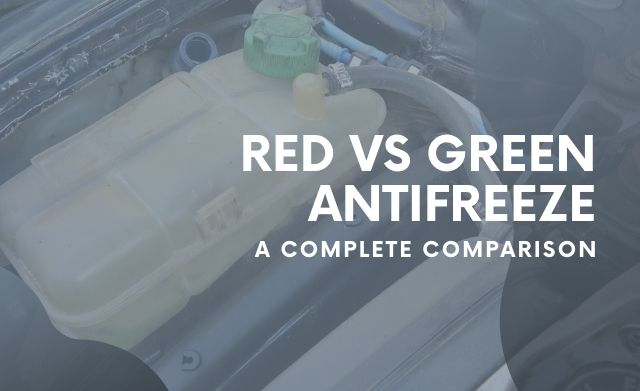
Antifreeze comes in several colors. Thus it makes many confused. The main difference between red and green antifreeze is their types, period of lasting, and additives used to produce them.
Whether it’s red, green, yellow, orange, or pink, all antifreeze is used to prevent corrosion, lubricate the moving parts, protect the engine from overheating, etc. Yet, there are differences between various types of antifreeze, while some lasts longer, some serve the machine comparatively for a short period of time.
I have seen many car owners taking antifreeze for granted. They take good care of other car factors but remain indifferent about antifreeze. That’s not a wise decision, and you should choose the best antifreeze to prolong your car engine’s lifespan.
Car engine continuously produces heat while running, and it’s crucial to be cooled/warmed to keep the temperature within a proper operating range. That’s why you recruit antifreeze (also known as coolant). The coolant passes through your car engine passages and keeps the temperature within the suitable range.
Basically, a coolant is a solution of antifreeze and water where the maximum ratio is between 50:50 and 60:40. The antifreeze lowers the freezing temperature by preventing the water in the radiator from boiling over up to 265℉. And at a lower temperature (down to -34℉), it prevents the water from freezing.
There are three basic types of antifreeze: IAT ( Inorganic additive technology), OAT (Organic additive technology), and HOAT (Hybrid OAT). All antifreeze is either ethylene glycol or propylene glycol.
The green or conventional green antifreeze is an older coolant type that uses IAT technology. These types of antifreeze need to be changed after a short period compared to the red antifreeze. On the other hand, red antifreeze is an OAT antifreeze that lasts for a longer time.
Usually, the older green antifreeze offers 2-3 years, or 50,000 miles change intervals. Contrarily, the red antifreeze provides higher protection to the engine for at least five years or 1,50,000 miles (or longer) before the coolant requires a replacement.
Table of Contents
Comparison chart
| Difference | Red antifreeze | Green antifreeze |
| Also known as | Dex-cool | Regular antifreeze or conventional green antifreeze |
| Used technology | OAT or organic additive technology | IAT or inorganic additive technology |
| Color | Red | Green |
| Glycol | Propylene glycol | Ethylene glycol |
| Used in | Modern engines | Older engines |
| Inhibitor additive | Organic inhibitor additives. Such as, Carboxylic acid | Inorganic inhibitor additives. Such as Silicate, phosphate, borate, etc. |
| Needs to be replaced after | Five years or 1,50,000 miles | Three years or 45,000 miles |
| Cost | Expensive compared to the green antifreeze | Inexpensive compared to the red antifreeze |
What is red antifreeze?
The red antifreeze is commonly known as dex-cool or propylene glycol and was first introduced in the 90s. All antifreeze works against rust, corrosion, and erosion of the cooling system. But, when it comes to red antifreeze, the specialty of this antifreeze is that it works for a much more extended period than the regular antifreeze or the conventional green antifreeze.
Different types of antifreeze vary from each other based on the inhibitor additives used to produce them. One of the crucial inhibitor additives in red antifreeze is a carboxylic acid. The common characteristic of carboxylic acid-produced compounds is that they drop out slowly. Hence, the red antifreeze extends the car engine’s life, and that’s why dex-cool is the number one choice for many.
So, what makes the colors of antifreeze different? Well, the formulation doesn’t play an important role in that case. It’s actually the antifreeze dyes that are responsible for the variation in colors of the antifreeze. And as for the color, the red antifreeze or Dex-cool is hard to tell when it’s the right time of replacement.
Red coolants protect the engine for up to 5 years or 1,50,000 miles and can be used in any car engine.
What is Green antifreeze?
Green antifreeze (or conventional green antifreeze or regular antifreeze) is an older technology of antifreeze that was widely used until the late 90s. This Inorganic technology-based coolant was first introduced in the early decades of the twentieth century and ruled the world of antifreeze before the younger OAT coolant came into existence.
However, the inorganic inhibitor additives are ethylene glycol-based antifreeze produced to prevent the engine’s corrosion, erosion, and rust. IAT is used in older engines only. The manufacturers no longer use this technology in newly produced machines.
Inorganic additive technology uses silicates, phosphates, borates, nitrate, nitrite, molybdate, etc. The characteristic of these types of components is that they drop out faster. As a result, conventional green oil’s replacement period is much shorter than the red coolant. Usually, the green antifreeze lasts for three years or around 50,000 miles before it is required to be replaced.
In Inorganic technology, the inhibitor additives create a foam layer to protect the engine metal parts such as regulator or coolant reservoir tanks from overheating or lower temperatures. And this extra foam layer slows down the typical heat exchange process. This process technically shortens the water pump’s life, and for that reason, IAT coolant is not recommended by experts, especially for modern engines.
Not to mention, the green antifreeze is inexpensive compared to the red antifreeze.
The key differences between red and green antifreeze
- Red antifreeze uses OAT or organic additive technology, while green antifreeze uses IAT or inorganic additive technology.
- Red antifreeze is also known as Dex-cool. And green antifreeze is an older technology that is also known as regular antifreeze or conventional green antifreeze.
- Red antifreeze is propylene glycol. On the other hand, green antifreeze is ethylene glycol.
- The red antifreeze uses organic inhibitor additives (e.g. carboxylic acid). Conversely, the inhibitor additives in green antifreeze are inorganic, such as silicates, phosphates, borates, nitrate, nitrite, molybdate, etc.
- Red antifreeze is used in modern cars, where green antifreeze is meant for older cars.
- You need to replace red antifreeze after every five years or 1,50,000 miles. Contrarily, green antifreeze lasts for 2-3 years or around 50,000 miles.
- Red antifreeze is costly compared to green antifreeze.
You should not mix red and green antifreeze.
Although there are hybrid coolants like HOAT (hybrid organic additive technology) or P-HOAT that last longer, yet you shouldn’t be mixing red and green antifreeze. The main reason behind is these two types of antifreeze use different formulations.
If you mix different coolant formulations together, this will decrease the coolant’s effectiveness. Such as the typical warming or cooling ability that it provides in various climates. Moreover, mixing coolants will debilitate the corrosion, erosion preventive power of the coolant.
According to automobile experts, if you switch from one type to another, you need to flush out the previous coolant entirely before replacing it with the new one. You should always make sure that two cooling types are not mixing at any point in your car.
Frequently asked questions
Does it matter what color coolant you use?
Using the correct type of coolant in your car matters a lot in many ways. The green antifreeze is meant for older engines. Manufacturers don’t use them in modern motors anymore. On the other hand, dex-cool or red antifreeze is especially a GM thing. You are not supposed to use them in Ford. The red antifreeze lasts way longer than the green antifreeze or conventional green antifreeze.
What happens if you use the wrong color antifreeze?
The usage of the wrong color antifreeze in your car engine may increase corrosion, rust, and erosion. Your engine might also give an incorrect reading and experience improper temperature management in different weather. You should always use the coolant that your manufacturers suggest.
What color is universal antifreeze?
The universal color of antifreeze is green. However, you should not mix this coolant with red or orange ones. The extra produced gel thorough mixing might damage your cooling system.
Conclusion
You should take coolant seriously to extend the life of your car engine. The coolant that provides your engine better protection for a longer time by preventing rust and corrosion and managing heat properly in various climate conditions is the right one. Which coolant is the right one for your car? Why and how to choose the correct one? Well, to erase this existing confusion in your mind, this article has described the difference between red and green antifreeze from various points.

Craig is a full-time academic and research-based article writer from California. A trained content creator who started his career as a column writer for local magazines and newspapers. His works have been published on many renowned online platforms.
